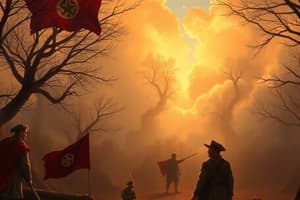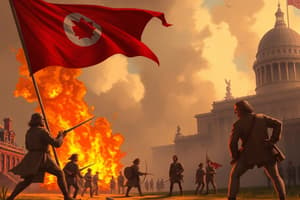Podcast
Questions and Answers
Explain how Shay's Rebellion revealed weaknesses in the Articles of Confederation, and suggest one specific way the Constitution addressed this weakness.
Explain how Shay's Rebellion revealed weaknesses in the Articles of Confederation, and suggest one specific way the Constitution addressed this weakness.
Shay's Rebellion exposed the inability of the federal government under the Articles to effectively suppress domestic unrest due to a lack of centralized military power and financial resources. The Constitution addressed this by granting the federal government the power to raise and support armies, as well as the power to tax.
Contrast the views of Federalists and Anti-Federalists regarding the necessity of a Bill of Rights. Why did Anti-Federalists feel it was essential, and how did the Federalists initially argue against it?
Contrast the views of Federalists and Anti-Federalists regarding the necessity of a Bill of Rights. Why did Anti-Federalists feel it was essential, and how did the Federalists initially argue against it?
Anti-Federalists believed a Bill of Rights was essential to explicitly protect individual liberties from potential government overreach. Federalists initially argued it was unnecessary because they believed the Constitution's structure inherently limited the government's power and that listing specific rights could imply that any rights not listed were not protected.
Describe the causes of the Whiskey Rebellion and explain how the government's response differed from its response to Shay's Rebellion, demonstrating the new powers granted to the federal government under the Constitution.
Describe the causes of the Whiskey Rebellion and explain how the government's response differed from its response to Shay's Rebellion, demonstrating the new powers granted to the federal government under the Constitution.
The Whiskey Rebellion was caused by opposition to a federal tax on whiskey, which disproportionately affected Western farmers. Unlike Shay's Rebellion, the federal government, under President Washington, quickly and decisively suppressed the uprising with a large military force, demonstrating the increased power and authority of the federal government under the Constitution.
Explain how impressment and trade restrictions affected the United States prior to the War of 1812, and identify one specific goal the U.S. hoped to achieve by declaring war.
Explain how impressment and trade restrictions affected the United States prior to the War of 1812, and identify one specific goal the U.S. hoped to achieve by declaring war.
What was the purpose of the Indian Removal Act, and how did the Cherokee Trail of Tears represent the consequences of this act for the 'Five Civilized Tribes'?
What was the purpose of the Indian Removal Act, and how did the Cherokee Trail of Tears represent the consequences of this act for the 'Five Civilized Tribes'?
Flashcards
Shay's Rebellion
Shay's Rebellion
An armed uprising in Massachusetts (1786-1787) by farmers against perceived economic injustices.
Articles of Confederation
Articles of Confederation
The first government of the United States (1781-1789), which lacked a strong central authority.
The Constitutional Convention
The Constitutional Convention
A gathering of delegates in 1787 to address the shortcomings of the Articles of Confederation, which resulted in drafting the U.S. Constitution.
Federalists
Federalists
Signup and view all the flashcards
The Bill of Rights
The Bill of Rights
Signup and view all the flashcards
Study Notes
- This study guide covers concepts in the unit "The New Nation" and the beginning of the unit "Expansion".
Shay's Rebellion
- An armed uprising in Massachusetts (1786–1787) led by Daniel Shays and other farmers against state and local enforcement of tax and debt judgments.
- Highlighted the weakness of the Articles of Confederation.
Articles of Confederation
- The first constitution of the United States, adopted in 1781.
- It established a weak central government with limited powers.
Confederacy or a Confederation
- A union of states or nations for a common purpose.
- Often associated with a weak central authority.
The Constitutional Convention
- A meeting in Philadelphia in 1787 where the U.S. Constitution was drafted.
- Addressed the problems of the weak central government under the Articles of Confederation.
Federalists
- Supporters of the U.S. Constitution during the ratification process.
- Advocated for a strong national government.
The Federalist Papers
- A series of 85 essays written by James Madison, Alexander Hamilton, and John Jay to persuade the citizens of New York to adopt the new Constitution.
- Important source for understanding the framers' intentions.
Anti-Federalists
- Opponents of the U.S. Constitution during the ratification process.
- Feared a strong national government and advocated for states' rights.
The Anti-Federalist Papers
- Essays and pamphlets written by opponents of the Constitution.
- Argued against a strong central government and in favor of protecting individual liberties.
The Constitution of the United States
- The supreme law of the United States, establishing a system of government with separation of powers and checks and balances.
The Bill of Rights
- The first ten amendments to the Constitution, guaranteeing fundamental rights and freedoms to individuals.
Whiskey Rebellion
- A tax protest in the United States beginning in 1791 during the presidency of George Washington.
- Farmers in western Pennsylvania protested a federal tax on whiskey.
Tarring and Feathering
- A form of public torture and punishment.
- Used to humiliate and intimidate people.
The French Revolution
- A period of social and political upheaval in late 1700's France.
- Ultimately toppled the monarchy and established a republic.
The Haitian Revolution
- A successful anti-slavery and anti-colonial revolt that occurred in the French colony of Saint-Domingue (now Haiti).
- Lasted from 1791 to 1804.
The Louisiana Purchase
- The acquisition of the Louisiana territory by the United States from France in 1803.
- Doubled the size of the U.S.
The War of 1812
- A military conflict between the United States and Great Britain.
- Lasted from 1812 to 1815.
Impressment
- The act of forcing people into military service.
- Was a major cause of the War of 1812.
The USS Constitution
- A wooden-hulled, three-masted heavy frigate of the United States Navy.
- One of the world's oldest commissioned naval vessels still afloat.
Andrew Jackson
- Seventh president of the United States (1829-1837).
- Known for his populism and his role in the Indian Removal Act.
The first two political parties of the United States
- The Federalists, led by Alexander Hamilton, and the Democratic-Republicans, led by Thomas Jefferson and James Madison.
- These parties emerged in the 1790s.
Spoils System
- The practice of rewarding political supporters with government jobs.
- Associated with Andrew Jackson.
Populism
- A political ideology that appeals to the common people.
- Often in contrast to the elite.
The “Five Civilized Tribes”
- The Cherokee, Chickasaw, Choctaw, Creek, and Seminole nations.
- Considered "civilized" by European settlers because they had adopted some aspects of European culture.
The Indian Removal Act
- A law passed in 1830 that authorized the forced removal of Native American tribes from their ancestral lands in the southeastern United States to lands west of the Mississippi River.
The Cherokee Trail of Tears
- The forced relocation of the Cherokee people from their lands in the southeastern United States to present-day Oklahoma in the 1830s.
- Resulted in thousands of deaths.
Studying That Suits You
Use AI to generate personalized quizzes and flashcards to suit your learning preferences.




